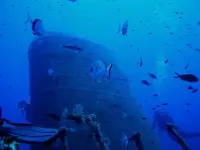Ok, I hope you can understand it correctly;
"MEXICO, DF Mexico-Spain and decided to work together for the first time in a plan to rescue the legendary galleon "Jones" sunk in 1631, a large shipment of gold and silver.
This is just one of many boats capsized colonial era and lie still with their valuable shipments under the waters off the coast of this country, as published by the website ansa.it.
El Pais newspaper revealed that a bilateral agreement to carry out this complex adventure will be signed during the forthcoming visit of President Enrique Peña Nieto to Spain.
The ship left the port of Veracruz, the scene of three foreign invasions of Mexico, and sank on October 31, 1631 against the shores of the state of Campeche, in the Gulf of Mexico, with 300 people on board of which only 39 survived.
The treasure had on board this vessel was estimated at one million 77 thousand 840 pesos a fabulous figure then incalculable prices current, but more interesting is that he was the greatest left loading "New World", according to the then viceroy New Spain, the Marquis of Cerralbo.
The Mexican government refuses to allow the Treasury rescue by people who are not employed by the State
According to the National Institute of Anthropology and History of Mexico, "the underwater cultural heritage belongs to the category of goods under study, safekeeping and distribution, which in themselves are inalienable and imprescriptible and not easily marketable."
Definitely the ship "Nuestra Señora del Juncal" is the "icing on the cake" of all ships that are submerged in the Mexican coast, including Santa Teresa and San Antonio ship sunk in the state of Tabasco, also in the Southeast.
Groups of "treasure hunters" have long sought to reach an agreement with the Mexican government to rescue the galleon, but the bureaucratic procedures moving very slowly.
"There are many shipwrecks in Mexico. Were working with the Mexican government to try to get the permissions but things take too long.'s Dealings with governments take a lot more than we delay doing business," said Mark Gordon, Odyssey Marine Exploration President, told BBC in October 2011.
But the Mexican government refuses to allow the rescue of people who are not employed by the government.
The story of the sunken galleon is fascinating and dates back to October 28, 1631, when it happened which is considered the most relevant to the history and archeology of Mexico underwater naval tragedy.
To go under, in the Gulf of Mexico, the flag-ship of the Fleet of New Spain from 1630-1631, Our Lady of Juncal, due to a powerful storm, precious metals that were with him were lost for at least nearly four centuries.
The ship had been damaged and began to take on water, so it was dragged to the coast of Campeche.
The Andres Aristizabal, Admiral thought that this would be their salvation but in the end only 39 people were saved in a boat and the rest died, including the captain himself.
Fernando Serrano, PhD in history from the University of Sevilla, considered overweight carrying the ships for carrying a huge cargo of precious metals and structural difficulties modifications were previously subjected to carry more troops and artillery were some of the causes of the wreck.
However, also attributed the tragedy to the fleet sailed in a wrong time of year when there are many Norths, weather accompanied by high winds and storms.
The fact that it has sunk in shallow waters just in the area where there are rich Mexican oil fields, called Campeche, and this is the most substantial cargo of gold and silver in history have become the most coveted project treasure hunters."






